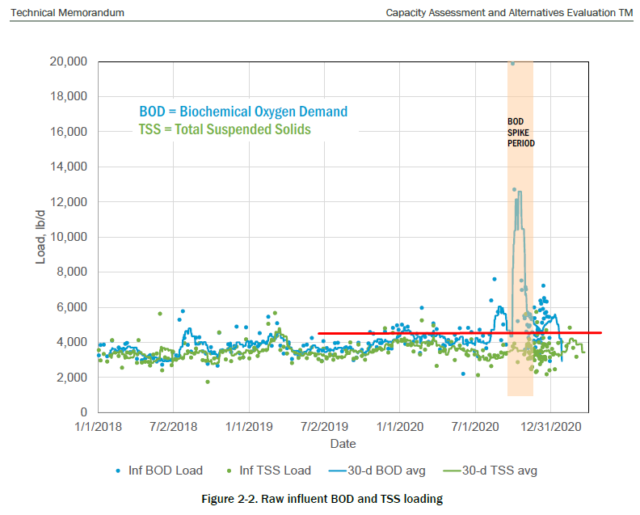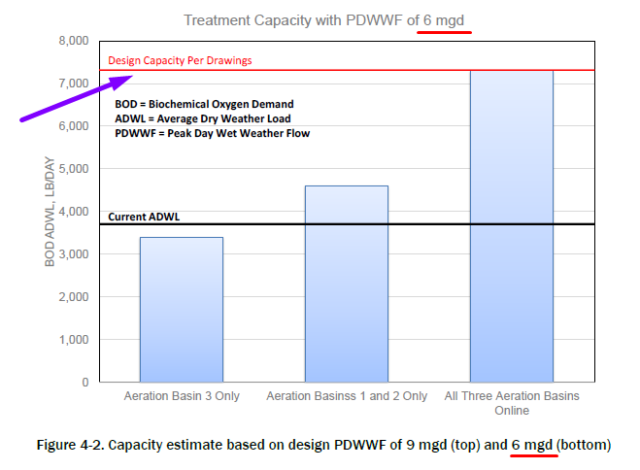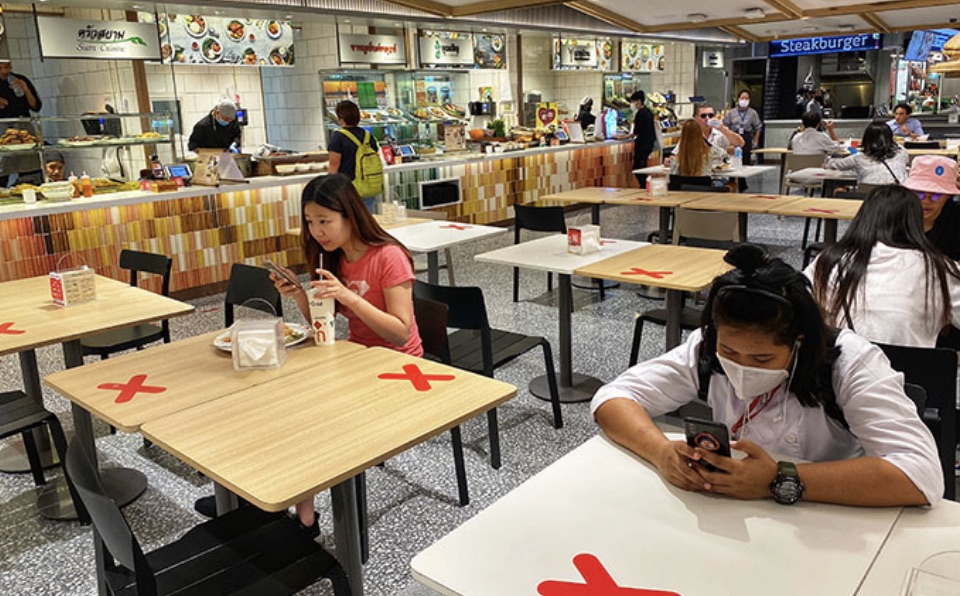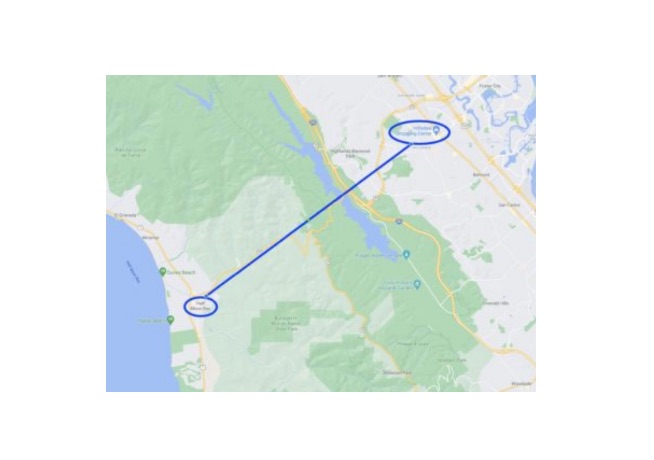|
Getting your Trinity Audio player ready...
|
 OWN VOICE. ~ InPerspective by Gregg Dieguez —
OWN VOICE. ~ InPerspective by Gregg Dieguez —
There is something getting everyone upset, and by everyone I include both residents and the processing at the Sewer Authority Mid-coastside (SAM) plant, which has seen processing upsets beginning last fall. Those upsets have created costs headed between $1 to 2 million, caused sewer flows with excess pollutants, and may result in fines by the Regional Water Quality Control Board. And there are implications for all of us: residents, businesses, and visitors.
I could have created a catchy title for this article: “Trouble Brewing at SAM” or “Something Fishy at SAM”, but that wording would have implied culpability by brewers or fishermen or restaurants, and the simple fact is: We Don’t Yet Know what is triggering the high levels of BOD (Biochemical Oxygen Demand) and TSS (Total Suspended Solids) in the SAM plant,. But there are things we do know, about the minimum this sewer processing problem will cost us, and there are some technical questions we should get answered, and then there is a possible, overarching problem we need to face: there are too many of us for the water we have in the sewers and likely – in an extended drought – in our faucets. So we need resolution of several policy issues to get back in balance with our environment. In order we will cover: the history of the upsets, who’s to blame (and who is NOT), technical questions, policy questions to be addressed, and some closing observations.
Footnotes: to use, click the bracketed number and then click your browser Back button to return to the text where you were reading.
Images: Click to enlarge for improved readability in a new window.

A Recent History of Sewer Upsets
For the better part of a year SAM has diligently been trying to cope with a series of unexpected spikes in Biochemical Oxygen Demand (BOD)[1] (chart at left). Those spikes have upset the friendly bacteria and critters who digest our wastewater pollutants and allow SAM to discharge effluent within regulatory limits into the ocean. The plant has tried a variety of additional treatment methods, with mixed success, but is unable to reliably meet the low levels of effluent BOD required by its permit. A few months ago, it retained Brown and Caldwell, a nationally recognized wastewater engineering consultancy, to examine the situation and recommend solutions. Their findings to date divide into two categories: A) find the source of the spikes in BOD submitted to the plant, and stop them (termed “collection system source control”), and B) re-engineer and expand the plant’s capacity to handle the flows it is receiving. The recommended alternative is to upgrade a currently unused aeration basin and bring it into the flow of operations. Details of the study can be viewed in the consultant’s report here. My understanding is that SAM has already voted in closed session to authorize Alternative #1.
Further, SAM is resurrecting a pre-existing Non-Domestic Waste Source Control Program (“NDWSCP”) adopted in 1994 and amended in 2014. This program allows SAM to surcharge non-domestic dischargers. This comes as a surprise to local businesses because it appears that all of the NDWSCP permits previously issued to non-domestic dischargers have lapsed while new breweries/distilleries have been issued permits to operate without obtaining NDWSCP permits from SAM. While the lawyer’s recommendation to SAM’s member agencies fingers “certain categories of dischargers— breweries, distilleries, and wineries —are suspected of being primarily responsible for the recent upsets…” SAM staff seems verbally much more gentle and collaborative in its approach. SAM has sent a letter to several local businesses[2] asking them to register and participate in providing information on their discharges, and to work with a consultant. The letter is careful to state that only businesses that FAIL to register and provide information will be subject to enforcement. However, those businesses are understandably very concerned about both the costs of any such NDWSCP program and the effects on their production.
To date, SAM has incurred about $600,000 of extra costs to deal with the series of processing upsets which have caused sewer discharges subject to potential violations. In addition, there will be about an additional $283,000 to $1,130,000 of capital investment to reconfigure the plant in an attempt to handle things more effectively (page 17 of the consultant’s report). Those figures do not include potential fines from the Regional Water Quality Control Board, legal expenses, or more testing and consulting until they identify the primary causes of excessive pollutants. Further, those estimates DO NOT include costs of containing or eliminating the BOD spikes, nor any estimate of perpetual additional ongoing operation and maintenance, or asset replenishment costs. A combination of detective work and/or the NDWSCP program are intended to address the spikes. I can foresee – without squinting too hard – an approximate near term $2 million price tag to be paid by current ratepayers as a result of the process problems.
SAM has hired a consultant to inspect and advise the local brewers and wineries. We shall see what we shall see, but the local breweries have made several points which suggest they are not our biggest headache. First, they haven’t changed their practices suddenly, last August and thereafter, when the spikes occurred. Second, their brewing volumes went DOWN during the Pandemic, and there’s no evidence they have fully recovered, or exceeded prior levels. Third, these local businesses seem to be very ecologically conscious, as for example this excerpt from a statement by the owner of a local brewery/pub:
At Hop Dogma, we have always taken several precautions to reduce potentially harmful discharges from entering our sewer system. All of our spent grain is placed in buckets and hauled off to a local ranch where it is used to feed livestock and other farm animals. We reuse our yeast regularly by recapturing it before kegging which substantially reduces what we put down our drains. Other organic materials used, such as hops, are often disposed of in the landfill or go out with our spent grain buckets to be used as fertilizer and compost…. We have always striven to limit our environmental impact and will continue to do so going forward. ” – Dan Littlefield
That establishment is using a process referred to as “side-streaming” to reduce the BOD of their effluent. My guess is that we will find similarly responsible behavior at the other firms. Over the past year, SAM has experienced higher than usual amounts of BOD/COD in their influent. In some cases the spikes have been so high that they exceeded the ability of their equipment to measure. Those spikes don’t sound, to me, like a recurring industrial process, but like illegal dumping or some major process disruption. SAM has been trying to find the location of the sources of those spikes, but beyond the firms which they’ve notified of a need for inspection, I’m unaware they’ve found any likely excessive BOD source. Testing for pollution is a little like star-gazing. Just as the starlight you see is already millions of years old, by the time you get the results of a pollution test, days or a week have gone by, and the event has passed. Perhaps we need a Community Sewer Bounty established, a reward for catching Midnight Dumpers.
But beyond finding single emitters, there is a bigger issue. Coastside tourism increased markedly after the worst of the Pandemic. We have continued adding population and businesses, and then we have encountered another drought. Sewers were engineered with a specific hydrology on the expectation of a specific average flow to carry the waste to a plant, back in the days before water conservation became an overwhelming necessity. In the West as a whole, it’s the driest year in 1,200-1,500 years, and sewer flows are down 65% in some areas. That’s a combination of people conserving, and a lack of infiltration and inflows to sewer systems from rainfall. As Pippin Cavagnaro of Nute Engineering explained at an MWSD meeting, drought adversely affects sewer systems in several ways: it reduces water flows, increases the concentration of pollutants, causes surface vegetation desperate for water to extend their roots down into sewer pipes, it allows some sewage to stagnate in the pipes and create septic conditions which smell and can corrode the pipes and pumps, makes it harder for the plant to treat the waste, and the lower flows make it harder for problematic discharges (like those so-called “flushable wipes” and swifters which don’t dissolve and clog sewers even during normal flow times) to more rapidly get caught in pipes, and the coping action for all the above is more manpower time and cost and water expended to flush clogs out and clean the sewer pipes. The obvious knock-on effect is that pipes and equipment wear out faster, processing costs and chemicals increase, and our sewer budget must grow[3]. In an ironic twist, our actions to conserve during a drought (low flush toilets {down from 5 gal/flush to 1.2 or less}, new age washing machines, low flow fixtures) make it harder for the sewer system to function efficiently – we’ve lost the “whoosh” factor we used to rely on for sewer hydraulics.
So, to recap the theories of why we have a sewer processing problem:
- Irresponsible, rogue dumpers of high BOD waste
- The Drought, making prior, acceptable levels of emissions more problematic without adequate sewer flows
- RV/camper traffic creating waste
- Fisheries, or fish processing plants
- Restaurants
- Higher levels of tourism after the worst of the Pandemic passed
- Additional houses built
- Additional ADU’s, which don’t require a new sewer connection, but increase population density and waste volumes
- Unregistered short term rentals, e.g. via AirBnb which also increase density and waste volumes on existing sewer connections
- All of the above combining to cross a tipping point which the SAM plant cannot handle without extra expense.
The last point is key. There are two concepts at work here: Cumulative Impacts, and Tipping Points. Every individual actor may have done nothing ‘wrong’, but as a sewer district and a society, we have allowed growth to progress beyond where our environment and infrastructure can cope. A similar issue likely exists with the TDML limits for emissions into creeks and harbors; everyone is doing what they always did, but now water flows are lower and the population density is higher: Voila, excessive pollution concentrations. We have the same issue with our Climate Crisis; we may have crossed some Tipping Points where things spiral out of control because the previously normal checks and balances can’t handle the new loads. In the case of a sewer plant, it’s designed to handle a combination of factors in a steady manner, but when you have unplanned and dramatic spikes in BOD, and you fall outside expected ranges, the entire ‘digestive process’ can be upset.
Technical Questions about the Proposed Solution
To that last point, I am asking Brown & Caldwell, the engineering firm who have advised SAM on the need for and design of investments in the treatment plant, several questions. Their report describes several alternatives, but has assumptions that I question, and the report may not go far enough in analyzing whether their new design is sufficient for real, current SAM conditions. Further, their report implies that even after the improvements are made, the plant may be at capacity. Which means: no more sewer connections, starting now. Here are my questions for B&C:

- Are we at capacity of the plant now, even after the pending improvements? Does Figure 4.2 imply that the plant is currently At Capacity? (with all 3 aeration basins in use). It would appear that 9 mgd is not a realistic scenario, but 6 mgd is (we have experienced 5.6 already), and that the plant is at capacity now – EXCLUDING all the spikes from unknown causes, AND EXCLUDING the year plus of influent BOD averaging between 420 and 450 mg/L.
- Is an extended drought going to make the influent BOD concentration problem worse? How close is SAM plant to capacity in an extended drought where flows average only 1 mgd? Can we do a sensitivity analysis about how much flow/ADWL will generate what degree of problem and costs?
- Since the B&C TechMemo did not deal with SVI above 200 mg/L, how do we know what will happen if the proposed changes are made and that limit is exceeded? Will SAM continue to operate out of compliance? Why was 200 SVI chosen?
- Once augmented by new equipment and processes, what will be the “real” flow capacities of the plant? Average? Peak mgd? Peak hourly WWF? (?Now theoretically: 4, 9, and 15mgd?)
- Sect. 5.6 used 340 mg/L for design, but per comments in 7/26 meeting, plant is receiving something over 410 mg/L frequently, not as ‘spikes’ but as a ‘new normal’. What would be plant capacity be if we used the 90% or 95% percentile of daily BOD influent, still omitting spikes in the thousands of BOD, but reflecting the ‘new normal’ above 400 mg/L?
- To answer the questions above, can we get a capacity ‘model’, or function, or equation SAM can use to test plant capacity plans against various assumptions of influent COD/BOD, water flow, and effluent concentration? Given the Climate Crisis, the concern is that we will experience extremes at both ends of what used to be a normal flow distribution, and more extreme concentrations, and SAM needs to know how robustly the recommended design can handle likely extremes.[4]
- Should agency flows be reported as BOD in addition to volumes? It would appear that “not all flows are created equal”. My understanding is that before the plant expansion in 1996-9, there were BOD limits. The old state permit included a loading factor.
Not everything will be settled by just getting answers to the above technical questions. There are a number of policy issues, and in an atmosphere with a 4 year lawsuit already underway, answers to these issues may be more difficult than the engineering solutions. Here are those issues:
- Who is going to pay for the extra costs SAM has, and will incur? Which connections and/or which agencies?
- Shouldn’t the Joint Powers Agreement be amended to include constraints on BOD/COD as well as volumetric flows?
- What extra pre-treatment options should be required for emitters above the BOD threshold?
- Given the likelihood of an extended drought, and the Bay Delta Plan, what should we be doing about more housing and ADU’s, and hotels, and other new businesses?
- Should SAM impose an immediate moratorium on new sewer connections by all agencies until these issues are fixed, finalized and costed? Why allow more damage?
- What are, and should be, the full costs of these “upsets” and their solution to ratepayers in each SAM member agency? To any New Joiners allowed?
- Why are these decisions being made and discussed in Closed Sessions when the community impact is so significant?
Closing Observations: This is a complex problem. It will take more months to resolve technically. I do see the parties operating in good faith, and responsibly. Unless we do find a few rogue dumpers, this is a problem of cumulative impacts, and not one of pointing fingers. So take a cleansing breath, and focus your attention and energy on advocating for a policy which is equitable to those already here, and which allows a sustainable Coastside going forward. Sustainable and equitable both environmentally, and fiscally.
FOOTNOTES:
[1] COD vs BOD
Another measure of sewer toxicity, which can be done more rapidly is Chemical Oxygen Demand (COD), so you may see that term used as well as BOD. Here’s an explanation of the terms.
[2] Local businesses mailed the NDWSCP letter:
- Half Moon Bay Brewing
- Hop Dogma
- Jetty Wave
- HMB Distillery
- Blue Ocean Brewing Co.
- Trojak’knier Winery
[3] Upside-down Water & Sewer Cost Dynamics:
And in another twist, lower water flows mean less money charged for both water and sewer use, at precisely the time when more money is needed to maintain the sewers in these trying conditions.
[4] Design Robustness Testing:
It’s completely understandable that a profit-driven consultancy on a fixed contract would narrow its workload to the most likely solution set as quickly as possible, and analyze that narrowly, rather than conducting a sensitivity analysis over a range of potential scenarios to assess the robustness of a recommended design. It would cost them profit margin to think out of the box, unless they’re paid to conduct such a robustness test. However, given the vulnerability of the small SAM plant to process upsets, the unusual variability of our current ecosystem, and the long timeframes and expensive procurement processes needed to make adjustments to plant infrastructure, it seems prudent to assess the boundaries for which a given solution will remain applicable, and to ensure the decision-makers are comfortable that those bounds cover the necessary range of potential scenarios.
More From Gregg Dieguez ~ InPerspective
Mr. Dieguez is a native San Franciscan, longtime San Mateo County resident, and semi-retired entrepreneur who causes occasional controversy on the Coastside. He is a member of the MCC, but his opinions here are his own, and not those of the Council. In 2003 he co-founded MIT’s Clean Tech Program here in NorCal, which became MIT’s largest alumni speaker program. He lives in Montara. He loves a productive dialog in search of shared understanding.






